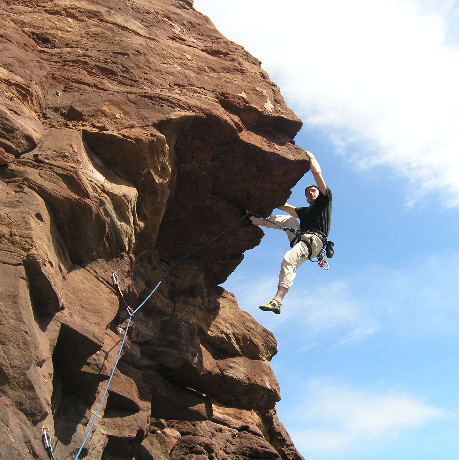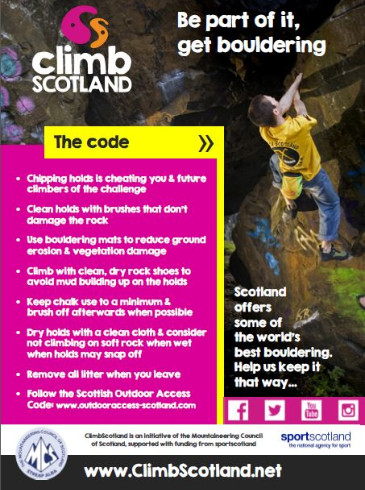W H Murray, second president of the MCofS (1972-1974) and world renowned mountaineer, conservationist and author, said:
“Here is a field of free action in which nothing is organised, or made safe or easy or uniform by regulation: a kingdom where no laws run and no useful ends fetter the heart.”
However there are commonly held mountaineering and climbing ethics which good climbers abide by. Some of these ethical issues can often seem ambiguous, especially so to non-climbers or those new to mountaineering.
Mountaineering ethics are a set of ideals that help us make decisions about every aspect of mountaineering, including where we climb, how we climb, how we treat our climbing environment and how we wish our sport to develop in the future.
Being responsible, for climbers, entails the following three basic principles:
Respecting the interests of other people
Respecting other users of the countryside includes considering the impact of the size of a visiting group or an event, or the regular use of a specific venue, and the greater risk of causing unreasonable interference. The Code also guides access users to accept reasonable requests from land managers for alternative access arrangements when some areas may not be safe while management operations are underway.
Caring for the environment
In general terms it is irresponsible, as well as illegal, for climbers to disturb birds and their young while they are nesting. Care for the cliff environment to reduce the impact on wildlife and plant life includes avoiding the uprooting flowers and rare plants, damage to trees, leaving visually intrusive climbing ‘litter’, keeping noise to a minimum and considering the suitability of the venue for larger groups. The use of hammer-placed protection is agreed to be a last resort and should be avoided wherever possible. An introduction to all the issues specifically for climbers can be found in the MCofS Minimal Impact Mountaineering Advice.
Take responsibility for your own actions
Climbers need to be aware of the legal principle volenti non fit injuria which means climbers taking access will generally be held to have accepted any obvious risks which are inherent in climbing, whether that is the soundness of the rock, condition of fixed or their own equipment etc. It is also a climber’s responsibility to assess their actions for the impact they will have on other people’s interests and the environment.
Participation and documentation of climbs
Climbing venues and climbs are documented by individual climbers (on the internet and in guidebooks). This is unregulated and the quality of the information is taken on trust by those who use it. This is undertaken on the full understanding that any description of a climb is for guidance only. Information regarding changes to climbs is updated in guidebooks and the internet by individuals, on an ad hoc basis.

Photo by Neil Shepherd
Personal responsibility
For all styles and disciplines of climbing, it is the ethic of the sport that all climbers take responsibility for their own actions. The Mountaineering Scotland Participation Statement makes this clear:
“Mountaineering Scotland recognises that climbing and mountaineering are activities with a danger of personal injury or death. Participants in these activities should be aware of and accept these risks and be responsible for their own actions and involvement.”
The Mountaineering Scotland Participation Statement relates to both those ‘developing’ new climbs and those ‘repeating’ climbs. Climbers should make their own assessment of the quality of any protection they use, both personal (climbing ‘gear’) and in-situ (protection left in the crag including pegs, slings and bolts). It is up to the individual to assess whether such protection is suitable to take a fall or be used in any way. This is part of the risk assessment required by individuals to participate as safely as they wish to.
Liability
Climbers cannot undertake the activity, understanding the risk and their responsibility then hold any other person liable for damages (including other climbers, first ascensionists / climb developers, guidebook authors and publishers, landowners and land managers etc.).
Self Regulation
Safety in climbing is a self-assessing and self-regulating system – natural environments, in-situ protection, protection opportunities and rock quality, as well as grade of difficulty of climb may change over time and so cannot be ‘governed’ by regulation, and cannot be maintained to a particular standard. The placement of bolts to produce sport climbs is also unregulated although Mountaineering Scotland recommends that they are placed in accordance with the manufacturer’s recommendations. The quality of in situ bolts on a sport climb can therefore be as variable as other forms of in situ protection.
Protection Replacement
Local climbers (or the first ascensionists) endeavour on an ad-hoc basis to replace in-situ ‘traditional’ protection (pegs, nuts, slings and threads) when they degrade, but often pegs and nuts cannot be replaced. The natural progression towards a ‘pure ascent’ of a climb without older in-situ protection is a recommended ethic in adventure climbing.
Climbers developing Sport Climbs may have a personal connection to the crag which allows for informal checking of bolt quality. This can be backed up by feedback from visiting climbers. A small number of local ‘bolt funds’ have been set up to help pay for the replacement of old bolts and Mountaineering Scotland supports this informal system and encourages climbers to support any local bolt fund.
Mountaineering Scotland's position on bolts can be found here.
Mountaineering Scotland, as a representative body, has conducted extensive consultation with climbers over many years and endorses the widely accepted view that adventurous bolt-free climbing remains the primary ethic for all Scottish climbs, but that there is a place for sports style climbing.
Established Climbing Venues:
New Sport Venues:
The development of sport climbs is welcomed within the context of a clear overall ethical framework
Mountaineering Scotland's position on bolts can be read here. These guidelines allow climbers to make informed decisions about sport development and allow the climbing world to self-regulate. If there are any doubts, or ‘grey areas’, an informal approach to gaining opinion is best at local level. Mountaineering Scotland will offer assistance (through awareness / distribution of information / debate / mediation) to aid consultation when required.
Although bouldering requires minimal gear it is not an 'anything goes' activity and it is expected that those taking part will be aware of their responsibilities as well as the freedoms of the sport. A simple code has been drawn up hich, if followed, will ensure that Scotland's buldering remains as it is now - some of the best in the world.
The Code:
